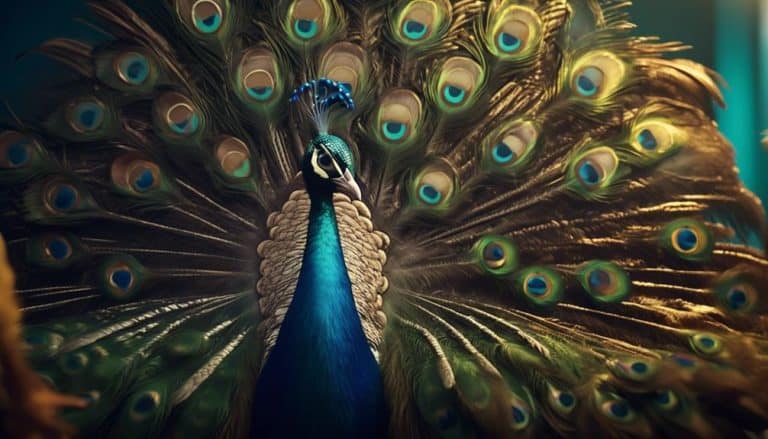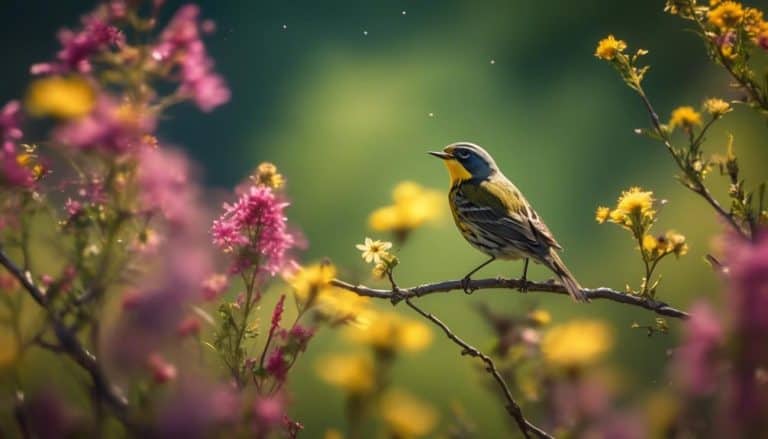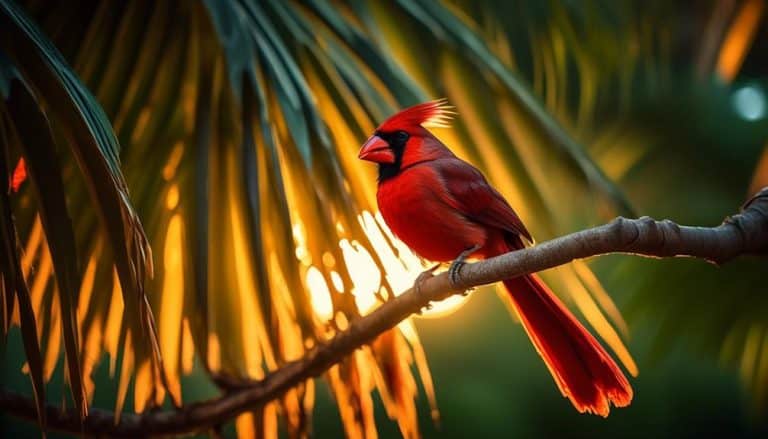As I stood in the midst of a Florida marsh, I couldn't help but notice the small black birds flitting about like tiny shadows on a sunlit canvas. Their presence intrigued me, and I found myself yearning to learn more about these elusive creatures.
What are they called, and what do we know about their behavior and habits? Join me as we uncover the secrets of these enigmatic birds and explore the diverse landscapes they call home.
Identification of Small Black Birds
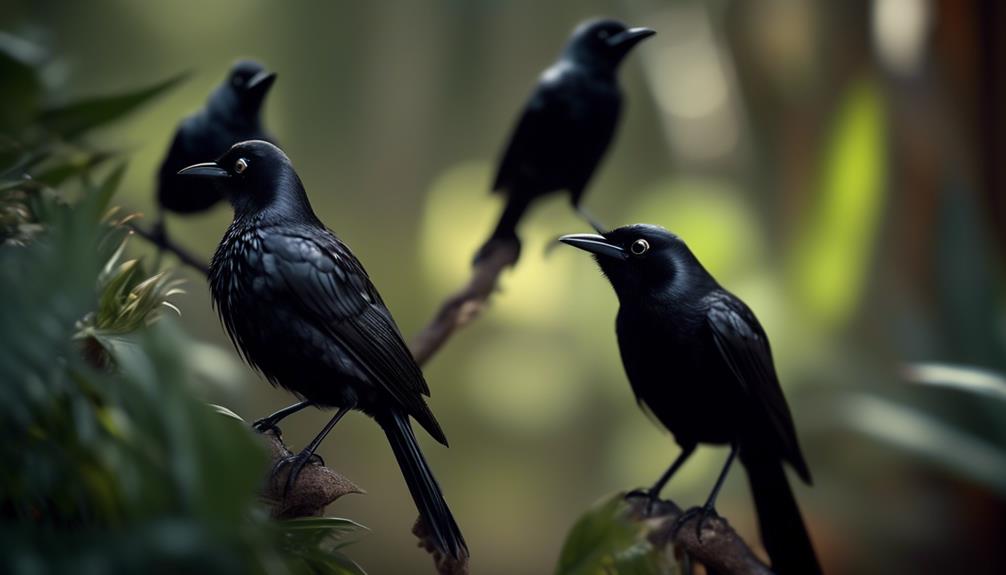
I will discuss the identification of small black birds in Florida.
When it comes to identifying these birds, it's important to pay attention to their behavioral characteristics and also take note of the breeding season.
One commonly found small black bird in Florida is the Common Grackle (Quiscalus quiscula). These birds are known for their glossy black plumage and striking yellow eyes. During the breeding season, the males display an iridescent blue or purple sheen on their feathers. They're often seen in large flocks, foraging on the ground or perched on trees.
Another small black bird species found in Florida is the Red-winged Blackbird (Agelaius phoeniceus). The males have black feathers with bright red shoulder patches, which they use to attract mates and defend their territory during the breeding season. They're known for their distinctive 'conk-la-ree' song, which can be heard in wetland habitats.
Lastly, the Boat-tailed Grackle (Quiscalus major) is another small black bird species commonly found in Florida. These birds have long, keel-shaped tails and are often seen near bodies of water. The males have iridescent black feathers with a purplish-blue sheen during the breeding season. They're known for their loud calls and elaborate courtship displays.
Distribution and Migration Patterns

The distribution and migration patterns of small black birds in Florida exhibit distinct patterns that are influenced by a combination of factors such as habitat availability, seasonal changes, and breeding behaviors. Understanding these patterns is crucial for conservation efforts and for predicting how these birds may respond to environmental changes.
| Factors Influencing Distribution and Migration Patterns | Examples |
|---|---|
| Habitat Availability | Coastal areas provide suitable feeding grounds for small black birds, while inland areas with dense vegetation offer ideal nesting sites. |
| Seasonal Changes | During the breeding season, small black birds tend to concentrate in specific regions with abundant food resources and suitable nesting conditions. In contrast, during the non-breeding season, they may disperse across a wider area in search of food. |
| Breeding Patterns and Reproductive Success | Small black birds typically exhibit a monogamous breeding system, with males and females sharing parental duties. The success of their breeding efforts depends on factors such as the availability of suitable nesting sites and food resources. |
| Impact of Climate Change on Migration Patterns | Climate change can significantly affect the timing and routes of migration for small black birds. Changes in temperature and precipitation patterns can alter the availability of food along their migratory routes, potentially leading to shifts in their timing or destinations. |
Habitats and Nesting Behavior

Small black birds in Florida exhibit specific habitat preferences and nesting behaviors that contribute to their distribution and overall population dynamics. Habitat destruction plays a significant role in shaping their habitats and nesting preferences.
These birds are commonly found in a variety of habitats, including forests, wetlands, and urban areas. However, they show a preference for habitats with dense vegetation, such as shrubs, trees, and thickets, which provide them with ample cover and nesting sites.
Nesting behavior varies among different species of small black birds in Florida. Some species build cup-shaped nests using twigs, grass, and other plant materials, while others construct cavity nests in tree hollows or abandoned woodpecker holes. These nesting preferences are influenced by factors such as competition for nest sites and protection from predators.
Habitat destruction poses a significant threat to the nesting success and population dynamics of these birds. Urbanization, deforestation, and the conversion of natural habitats into agricultural land have led to the loss of suitable nesting sites and reduced availability of food resources. Consequently, the populations of some species have declined as a result of these human activities.
Understanding the habitat preferences and nesting behaviors of small black birds in Florida is crucial for conservation efforts. Protecting and restoring their preferred habitats, implementing nest box programs, and managing human activities in their habitats can help mitigate the negative impacts of habitat destruction and ensure the long-term survival of these charismatic birds.
Feeding Habits and Diet

Having explored the habitat preferences and nesting behaviors of small black birds in Florida, it's now important to delve into their feeding habits and diet.
These birds exhibit a diverse range of feeding preferences, which allow them to efficiently forage in their environment. While some species primarily feed on fruits and berries, others focus on insects and small invertebrates. This variation in diet is influenced by factors such as beak morphology, body size, and ecological niche.
Feeding preferences among these birds can be categorized into two main groups: frugivorous and insectivorous. Frugivorous birds, such as the Red-winged Blackbird, have a penchant for consuming various fruits and berries that are abundant in their habitats. They play a crucial role in seed dispersal, aiding in the regeneration of plant species. On the other hand, insectivorous birds, like the Common Grackle, rely heavily on insects and small invertebrates as their primary source of nutrition. They employ a range of foraging techniques, including probing and pecking, to locate and capture their prey.
In addition to fruits and insects, some small black birds also supplement their diet with nectar from flowers, sap from trees, and even small vertebrates like lizards and frogs. This dietary flexibility allows them to adapt to changing environmental conditions and ensure their survival.
Interactions With Other Bird Species
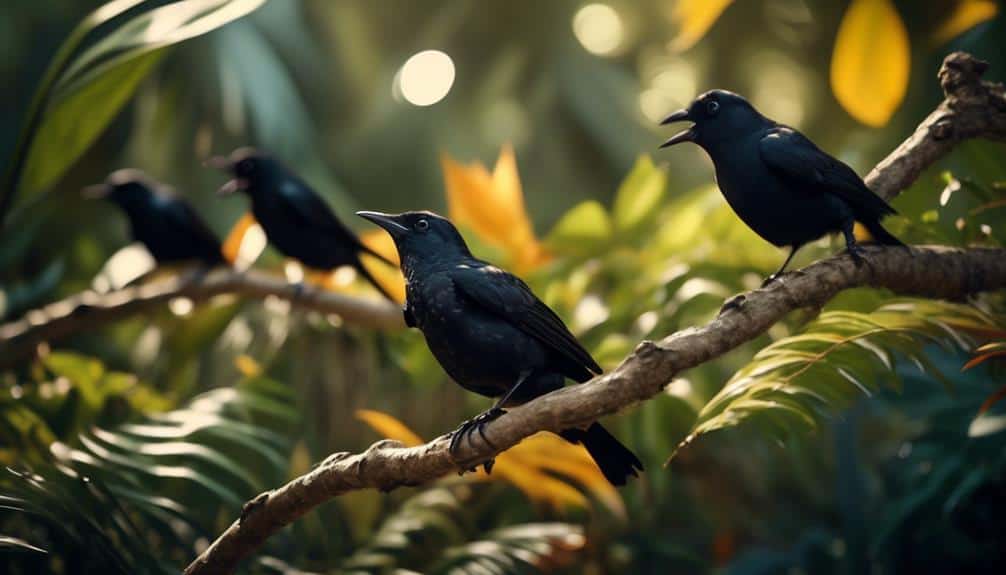
Interactions between small black birds in Florida and other bird species play a significant role in shaping the dynamics of their local ecosystems. These interactions involve both predation risks and competition for resources, as well as cooperative behavior and social interactions. To understand these interactions better, let's explore the ways in which small black birds interact with other bird species in Florida.
| Interactions with Other Bird Species | Role in Ecosystem |
|---|---|
| Predation Risks | – Small black birds may become prey for larger bird species, such as hawks or owls. This predation risk influences their behavior and foraging patterns, as they need to be cautious and stay vigilant to avoid being caught. |
| Competition for Resources | – Small black birds compete with other bird species for food, nesting sites, and territories. This competition can be intense, especially during breeding seasons when resources are limited. It may lead to changes in habitat use and foraging strategies to ensure their survival and reproductive success. |
| Cooperative Behavior and Social Interactions | – Small black birds often form mixed-species flocks with other bird species, such as warblers or sparrows. These flocks provide benefits such as increased foraging efficiency, predator detection, and protection. They communicate and cooperate with each other, demonstrating complex social interactions that enhance their chances of survival. |
Understanding the interactions between small black birds and other bird species in Florida is crucial for comprehending the dynamics of their local ecosystems. These interactions shape their behavior, foraging patterns, and overall survival strategies. By studying these interactions, scientists can gain insights into the intricate web of relationships within bird communities and the overall functioning of the ecosystem.
Conservation Efforts and Challenges

Conservation efforts and challenges in the context of small black birds in Florida encompass various strategies aimed at preserving their habitats and mitigating threats to their populations. These small birds face several threats that have led to declining population numbers. One of the major threats is habitat loss due to urbanization and agricultural expansion. As their natural habitats are destroyed or fragmented, the birds struggle to find suitable nesting sites and sources of food.
To address these challenges, conservation initiatives have been implemented in Florida. One such initiative is the preservation and restoration of wetlands, which are important breeding and foraging grounds for these birds. Wetland conservation projects involve restoring natural water flow, controlling invasive species, and protecting nesting areas from disturbance.
Another conservation strategy focuses on creating artificial nesting sites, such as nest boxes and platforms, to compensate for the loss of natural nest sites. These structures provide safe and suitable breeding environments for the black birds.
Additionally, public awareness campaigns and educational programs are vital in raising awareness about the importance of protecting these birds and their habitats. By involving the local community, volunteers, and stakeholders, conservation efforts can be enhanced and sustained.
Despite these conservation initiatives, challenges still persist. Climate change poses a significant threat to these birds, as rising temperatures and changing weather patterns can disrupt their breeding and migration patterns. Predation by invasive species and pesticide use also contribute to their declining populations.
Frequently Asked Questions
Are Small Black Birds Common in Other Parts of the United States or Are They Primarily Found in Florida?
Small black birds are not exclusive to Florida; they can be found in other parts of the United States as well. Some species may migrate, while others may be year-round residents.
Do Small Black Birds Have Any Unique Behaviors or Calls That Help to Differentiate Them From Other Bird Species?
Small black birds exhibit unique behaviors and distinguishing calls that set them apart from other bird species. These behaviors and calls serve as important characteristics for identifying and differentiating them in the field.
How Do Small Black Birds Interact With Humans in Urban Areas, Such as Parks or Residential Neighborhoods?
In urban areas, small black birds, like any other bird species, interact with humans in various ways. They may build nests in trees or on buildings, scavenge for food, or simply coexist peacefully.
Are There Any Specific Threats or Predators That Small Black Birds Face in Their Habitats?
In my research, I discovered that small black birds in their habitats face specific threats and predators. It is important to study these interactions and understand how it impacts their populations and overall ecosystem health.
Do Small Black Birds Have Any Significant Impact on the Local Ecosystem or Other Bird Species in Florida?
I've observed that small black birds in Florida have a significant impact on the local ecosystem and interact with other bird species. They play a vital role in seed dispersal and pest control, benefiting the overall health and balance of the ecosystem.
Conclusion
In conclusion, small black birds in Florida have a diverse range of species with unique characteristics and behaviors.
One interesting statistic is that the most common small black bird in Florida is the Red-winged Blackbird (Agelaius phoeniceus), with an estimated population of over 10 million individuals.
These birds play an important role in the ecosystem, contributing to seed dispersal and insect control.
However, habitat loss and climate change pose significant challenges to their conservation.
It's crucial to continue studying and protecting these fascinating birds for the future generations to enjoy.


